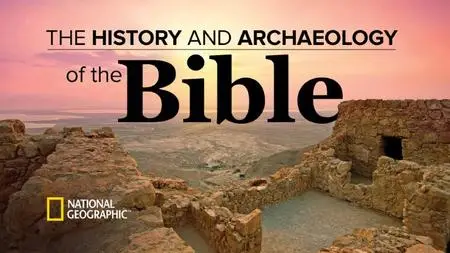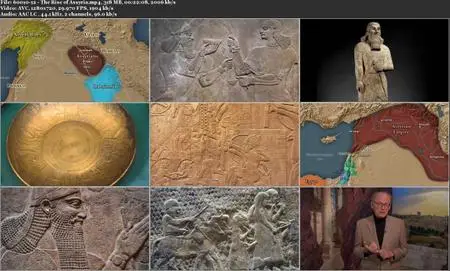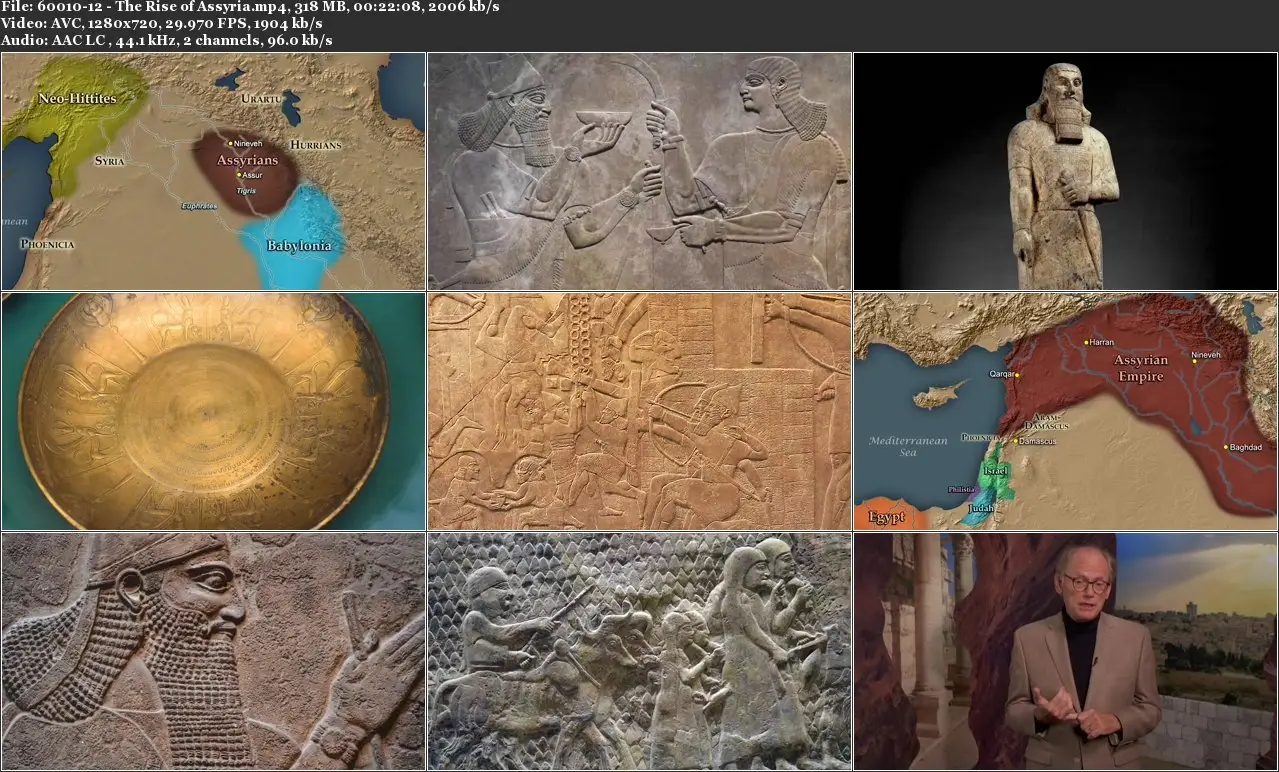TTC Video - The History and Archaeology of the Bible
.MP4, AVC, 1280x720, 30 fps | English, AAC, 2 Ch | 11h 17m | 9.49 GB
Lecturer: Jean-Pierre Isbouts, DLitt National Geographic Historian, Fielding Graduate University | Course No. 60010
.MP4, AVC, 1280x720, 30 fps | English, AAC, 2 Ch | 11h 17m | 9.49 GB
Lecturer: Jean-Pierre Isbouts, DLitt National Geographic Historian, Fielding Graduate University | Course No. 60010
As one of the foundational documents of Western civilization, the Bible has impacted our culture perhaps more than any other written work. Its influence on our religious, spiritual, and philosophical conceptions; our notions of morality and social justice; and on Western art, literature, and history would be hard to exaggerate.
Of course, the Bible is not a history book. It’s a book of faith, and, above all, its writings have religious and spiritual intent. Yet, each of its stories originated in a particular place and time, and many of them intersect meaningfully with what we know about the ancient world.
As a result, the work of historians and archaeologists opens a thrilling world of discovery, as they bring their methods and insights to bear on the beloved narratives of the Bible. No matter what your relationship to the Bible is, fascinating and illuminating perspectives on the texts come from looking at the Judeo-Christian scriptures through the disciplines of history and archaeology:
The reference in Exodus to the waters of the Nile turning to blood correlates with a phenomenon of the Nile’s ecosystem that periodically turns the waters red;
Egyptian records from the 1280s BCE mirror the biblical story of the enslaved Israelites building garrison cities for the Pharaoh, speaking of the same sites mentioned in the Bible;
The legendary Temple of Solomon is lost to history, but excavations in the 1980s in the Negev Desert unearthed a shrine showing what it may have looked like, containing the same key features known to have characterized Solomon’s Temple; and
Excavations in Jerusalem in the 1960s uncovered a large stairway that is likely to be the stairway used by Jesus and the Apostles to enter the Temple following their stay in Bethany.
Speaking to these matters and many more, we have joined with National Geographic to present The History and Archaeology of the Bible, which takes you on a multidimensional journey through the Bible from Genesis to the Crucifixion, seen through the lens of the latest historical and archaeological findings, and accompanied by vivid video footage of many of the sites where the stories of the Bible unfolded.
Discover the Historical Context of the Scriptures
Taught by Jean-Pierre Isbouts, a National Geographic contributor, eminent biblical historian, and award-winning filmmaker, these 24 richly detailed lessons include 47 video sequences created especially for this course, bringing alive key narratives of the Bible and their historical settings, and taking you to ancient places such as:
The spot on Mt. Sinai where tradition says God spoke to Moses as a burning bush;
The great northern Israelite city of Samaria;
Solomon’s fortresses of Hazor and Megiddo;
The renowned Roman trade crossroads of Petra, a jewel of the ancient world;
The imposing mountaintop stronghold of Masada;
Roman Scythopolis, one of the most impressive archaeological sites in Israel; and
The Mount of Beatitudes, held to be the spot where Jesus delivered his great sermon.
Covering seminal books of the Hebrew Bible (the Old Testament) such as Genesis, Exodus, Prophets, Kings, and Samuel, as well as core events of the New Testament, the course follows the arc of ancient civilization, reflecting on the majestic empires of Mesopotamia, Egypt, Assyria, Babylonia, Persia, Greece, and Rome. Throughout, Professor Isbouts enriches the lessons with 3D models, hundreds of vibrant images, and many of the greatest works of Western art.
Walk in the Footsteps of the Bible’s Major Figures
Professor Isbouts’s dynamic commentary reveals eye-opening perspectives on biblical narratives such as:
Genesis—Examine evidence from ancient Sumer of a catastrophic flood that occurred 5,000 years ago and discover that the technology to build a vessel such as Noah’s Ark actually existed in those times. Explore the spiritual meaning of towers in the ancient world and study Mesopotamian architectural forms that may correlate with the story of the Tower of Babel.
The Exodus from Egypt—Take account of the devastating plagues of flies, frogs, locusts, and hailstorms that prefigured the Exodus and their relation to known environmental phenomena. Trace the geographical path of Moses and the Israelites, a well-traveled artery through mining regions, oases, and trade routes from Egypt to the Midian, the region southeast of Sinai.
The Kingship of David—Relive the phenomenal rise of David, his military exploits, and his troubled rule as king of the Hebrews. Study archaeological evidence supporting the story in Samuel of how David took Jerusalem and visit structures excavated in the “City of David,” which may embody the core of David’s residential and administrative complex.
Israel under the Assyrians—Learn how an ancient clay document confirms the Bible’s account of the Assyrian invasion of Judah, also corroborated by excavations in Jerusalem in the 1960s. View the magnificent Assyrian tableaux that depict the siege of the city of Lachish and the submission of the Israelites, described in the Bible.
Herod’s Kingdom—Assess the profound impact of the 33-year reign of Herod, Roman ruler of Galilee at the time of Jesus’s birth. Witness the dramatic events through which the Romans voted Herod “King of the Jews”. Learn how he changed the face of Roman Judea through building projects, such as his showpiece city of Sebaste and the huge port of Caesarea Maritima.
The Early Life of Jesus—Take a penetrating look at the conditions in Galilee during the youth of Jesus, which indicate that those years were one of the most violent periods in Galilean history. Learn about the peasant revolts and reprisals that devastated the country, after which Joseph and Jesus were likely to have been conscripted laborers for the Romans.
In addition to exploring connections between the scriptures and the historical record, Professor Isbouts also draws attention to cases where the findings of historians and archaeologists differ from biblical accounts. For example, we have little archaeological evidence of the large-scale military conquests of Joshua or of the great power and prosperity of the Israelite nation under Solomon, as portrayed in scripture. In cases such as these, Professor Isbouts discusses how historians and archaeologists think about them. He highlights the current state of our archaeological knowledge, which is always subject to new data.
Professor Isbouts’s great flair as a storyteller and his phenomenal depth of knowledge of the subject matter make the lessons consistently enthralling and enlightening. Accompanied by Professor Isbouts’s historical commentary and video footage of the story’s setting, you’ll hear the astonishing story of Joseph’s captivity in Egypt and his rise from the rank of slave to vizier to the pharaoh. You’ll make intriguing linguistic connections, such as the fact that the Greek term eu-angelion, giving us the English evangelism, translates as “good news.” And, you’ll learn amazing facts. The event in Exodus of the rain of “manna” (bread) from heaven correlates with a secretion of small insects in the Sinai, which drops to the ground and can be gathered and made into wafers.
Deeply fascinating for those who have an interest in the Abrahamic faiths, ancient civilizations, and archaeology, The History and Archaeology of the Bible throws fresh and revealing light on the iconic scriptures that—in far-reaching ways—have shaped our world.
The reference in Exodus to the waters of the Nile turning to blood correlates with a phenomenon of the Nile’s ecosystem that periodically turns the waters red;
Egyptian records from the 1280s BCE mirror the biblical story of the enslaved Israelites building garrison cities for the Pharaoh, speaking of the same sites mentioned in the Bible;
The legendary Temple of Solomon is lost to history, but excavations in the 1980s in the Negev Desert unearthed a shrine showing what it may have looked like, containing the same key features known to have characterized Solomon’s Temple; and
Excavations in Jerusalem in the 1960s uncovered a large stairway that is likely to be the stairway used by Jesus and the Apostles to enter the Temple following their stay in Bethany.
Speaking to these matters and many more, we have joined with National Geographic to present The History and Archaeology of the Bible, which takes you on a multidimensional journey through the Bible from Genesis to the Crucifixion, seen through the lens of the latest historical and archaeological findings, and accompanied by vivid video footage of many of the sites where the stories of the Bible unfolded.
Discover the Historical Context of the Scriptures
Taught by Jean-Pierre Isbouts, a National Geographic contributor, eminent biblical historian, and award-winning filmmaker, these 24 richly detailed lessons include 47 video sequences created especially for this course, bringing alive key narratives of the Bible and their historical settings, and taking you to ancient places such as:
The spot on Mt. Sinai where tradition says God spoke to Moses as a burning bush;
The great northern Israelite city of Samaria;
Solomon’s fortresses of Hazor and Megiddo;
The renowned Roman trade crossroads of Petra, a jewel of the ancient world;
The imposing mountaintop stronghold of Masada;
Roman Scythopolis, one of the most impressive archaeological sites in Israel; and
The Mount of Beatitudes, held to be the spot where Jesus delivered his great sermon.
Covering seminal books of the Hebrew Bible (the Old Testament) such as Genesis, Exodus, Prophets, Kings, and Samuel, as well as core events of the New Testament, the course follows the arc of ancient civilization, reflecting on the majestic empires of Mesopotamia, Egypt, Assyria, Babylonia, Persia, Greece, and Rome. Throughout, Professor Isbouts enriches the lessons with 3D models, hundreds of vibrant images, and many of the greatest works of Western art.
Walk in the Footsteps of the Bible’s Major Figures
Professor Isbouts’s dynamic commentary reveals eye-opening perspectives on biblical narratives such as:
Genesis—Examine evidence from ancient Sumer of a catastrophic flood that occurred 5,000 years ago and discover that the technology to build a vessel such as Noah’s Ark actually existed in those times. Explore the spiritual meaning of towers in the ancient world and study Mesopotamian architectural forms that may correlate with the story of the Tower of Babel.
The Exodus from Egypt—Take account of the devastating plagues of flies, frogs, locusts, and hailstorms that prefigured the Exodus and their relation to known environmental phenomena. Trace the geographical path of Moses and the Israelites, a well-traveled artery through mining regions, oases, and trade routes from Egypt to the Midian, the region southeast of Sinai.
The Kingship of David—Relive the phenomenal rise of David, his military exploits, and his troubled rule as king of the Hebrews. Study archaeological evidence supporting the story in Samuel of how David took Jerusalem and visit structures excavated in the “City of David,” which may embody the core of David’s residential and administrative complex.
Israel under the Assyrians—Learn how an ancient clay document confirms the Bible’s account of the Assyrian invasion of Judah, also corroborated by excavations in Jerusalem in the 1960s. View the magnificent Assyrian tableaux that depict the siege of the city of Lachish and the submission of the Israelites, described in the Bible.
Herod’s Kingdom—Assess the profound impact of the 33-year reign of Herod, Roman ruler of Galilee at the time of Jesus’s birth. Witness the dramatic events through which the Romans voted Herod “King of the Jews”. Learn how he changed the face of Roman Judea through building projects, such as his showpiece city of Sebaste and the huge port of Caesarea Maritima.
The Early Life of Jesus—Take a penetrating look at the conditions in Galilee during the youth of Jesus, which indicate that those years were one of the most violent periods in Galilean history. Learn about the peasant revolts and reprisals that devastated the country, after which Joseph and Jesus were likely to have been conscripted laborers for the Romans.
In addition to exploring connections between the scriptures and the historical record, Professor Isbouts also draws attention to cases where the findings of historians and archaeologists differ from biblical accounts. For example, we have little archaeological evidence of the large-scale military conquests of Joshua or of the great power and prosperity of the Israelite nation under Solomon, as portrayed in scripture. In cases such as these, Professor Isbouts discusses how historians and archaeologists think about them. He highlights the current state of our archaeological knowledge, which is always subject to new data.
Professor Isbouts’s great flair as a storyteller and his phenomenal depth of knowledge of the subject matter make the lessons consistently enthralling and enlightening. Accompanied by Professor Isbouts’s historical commentary and video footage of the story’s setting, you’ll hear the astonishing story of Joseph’s captivity in Egypt and his rise from the rank of slave to vizier to the pharaoh. You’ll make intriguing linguistic connections, such as the fact that the Greek term eu-angelion, giving us the English evangelism, translates as “good news.” And, you’ll learn amazing facts. The event in Exodus of the rain of “manna” (bread) from heaven correlates with a secretion of small insects in the Sinai, which drops to the ground and can be gathered and made into wafers.
Deeply fascinating for those who have an interest in the Abrahamic faiths, ancient civilizations, and archaeology, The History and Archaeology of the Bible throws fresh and revealing light on the iconic scriptures that—in far-reaching ways—have shaped our world.





